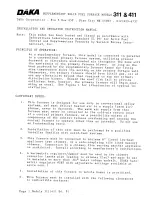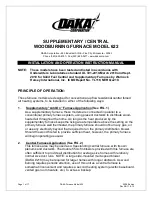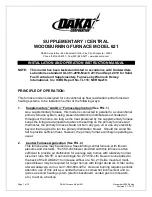
29
7. Replace regulator screw cover and finger-tighten securely.
8. Turn OFF all electrical power to the system.
9. Remove manometer and hose from outlet pressure tap.
10. Tighten outlet pressure tap clockwise 7 in-lbs minimum to
seal port.
11. Turn ON system power and set thermostat to call for heat.
12. Using a leak detection solution or non-chlorine soap suds,
check for leaks at hose connection. Bubbles forming
indicate a leak. SHUT OFF GAS AND FIX ALL LEAKS
IMMEDIATELY!
Measure gas manifold pressure with burners firing. Adjust mani-
fold pressure per the
Manifold Gas Pressure
table.
Any necessary major changes in gas flow rate should be made by
changing the size of the burner orifice.
G
AS
I
NPUT
R
ATE
M
EASUREMENT
(N
ATURAL
G
AS
O
NLY
)
The gas input rate to the furnace must never be greater than that
specified on the unit rating plate. To measure natural gas input
using the gas meter, use the following procedure.
1. Turn OFF the gas supply to all other gas-burning appliances
except the furnace.
2. While the furnace is operating, time and record one
complete revolution of the smallest gas meter dial.
3. Calculate the number of seconds per cubic foot (sec/ft
3
) of
gas being delivered to the furnace. If the dial is a one cubic
foot dial, divide the number of seconds recorded in step 2
by one. If the dial is a two cubic foot dial, divide the number
of seconds recorded in step 2 by two.
4. Calculate the furnace input in BTUs per hour (BTU/hr). Input
equals the installation’s gas heating value multiplied with
a conversion factor (hours to seconds), divided by the
number of seconds per cubic foot. The measured input
must not be greater than the input indicated on the unit
rating plate.
EXAMPLE:
Installation’s gas heating (HTG) value: 1,000 BTU/ft
3
(Obtained from gas supplier)
Installation’s seconds per cubic foot: 34 sec/ ft
3
Conversion Factor (hours to seconds): 3600 sec/hr
Input = (Htg. value x 3600) ÷ seconds per cubic foot
Input = (1,000 BTU/ft
3
x 3600 sec/hr) ÷ 34 sec/ ft
3
Input = 106,000 BTU/hr
Minor changes to the input rate may be accomplished through
manifold pressure adjustments at the gas valve. Refer to
Section
XIV, Startup Procedure and Adjustment - Gas Manifold Pressure
Measurement and Adjustment
for details.
NOTE:
The final mani-
fold pressure cannot vary by more than ± 0.3” w.c. from the speci-
fied setting. Consult your local gas supplier if additional input rate
adjustment is required.
5. Turn ON gas to and relight all other appliances turned off in
step 1. Be certain that all appliances are functioning properly
and that all pilot burners are operating.
T
EMPERATURE
R
ISE
Temperature rise must be within the range specified on the unit
rating plate. An incorrect temperature rise may result in condens-
ing in or overheating of the heat exchanger. An airflow and tem-
perature rise table is provided in the Product Data Book applicable
to your model*. Determine and adjust temperature rise as fol-
lows:
1. Operate furnace with burners firing for approximately ten
minutes. Ensure all registers are open and all duct
dampers are in their final (fully or partially open) position.
2. Place thermometers in the return and supply ducts as close
to the furnace as possible. Thermometers must not be
influenced by radiant heat by being able to “see” the heat
exchanger.
RISE =
SUPPLY
AIR
RETURN
AIR
HEAT EXCHANGER
RADIATION "LINE OF SIGHT"
T
RETURN
T
SUPPLY
T
SUPPLY
-
T
RETURN
Temperature Rise Measurement
3. Subtract the return air temperature from the supply air
temperature to determine the air temperature rise. Allow
adequate time for thermometer readings to stabilize.
4. Adjust temperature rise by adjusting the circulator blower
speed. Increase blower speed to reduce temperature rise.
Decrease blower speed to increase temperature rise. Refer
to
Section XIV, Startup Procedure and Adjustment -Circulator
Blower Speeds
for speed changing details.
C
IRCULATOR
B
LOWER
S
PEEDS
WARNING
T
O PREVENT PREMATURE FAILURE OF HEAT EXCHANGER, PROPERTY DAMAGE,
PERSONAL INJURY OR DEATH, DO NOT ADJUST THE LIMIT CONTROL (FACTORY
SET).
This furnace is equipped with a multi-speed circulator blower. This
blower provides ease in adjusting blower speeds. The Product
Data Book applicable to your model* provides an airflow table,
showing the relationship between airflow (CFM) and external static
pressure (E.S.P.), for the proper selection of heating and cooling
speeds. The cooling blower speed is shipped set on HIGH, and
the heating blower speed is set as indicated in the Product Data
Book applicable to your model*. These blower speeds should be
adjusted by the installer to match the installation requirements so
as to provide the correct heating temperature rise and correct cool-
ing CFM.
To adjust the circulator blower speed, proceed as follows:
1. Turn OFF power to the furnace.
2. Select the heating and cooling blower speeds that match
the installation requirements from the
airflow table in the
Product Data Book
.
3. Relocate desired motor leads to the circulator blower heat
and cool speed terminals on the integrated control module.
(Terminals are identified as HEAT and COOL (hot)). If heating
and cooling blower speeds are the same, a jumper wire
must be used between the heat and cool terminals.
4. Connect all unused blower motor leads to the “PARK”
terminals on the integrated control module. Any leads not
connected to the “PARK” terminals must be taped.
5. Turn ON power to furnace.









































